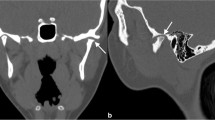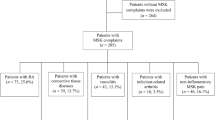Abstract
Musculoskeletal (MSK) presentations are common, ranking highly in the self-reported health problems amongst adolescents, and result from a spectrum of causes. The evidence-based approach to paediatric and adolescent MSK clinical examination includes a basic examination (pGALS) and a more detailed regional MSK examination (pREMS). These tools were developed in recognition that ‘children are not little adults’. The MSK assessment must be interpreted in the context of general assessment, suspected ‘red flags’ and systemic enquiry. The importance of early diagnosis and prompt referral of suspected MSK disease to specialist teams is increasingly relevant in the era of potent treatments for AYA with rheumatic disease but also applies to other MSK conditions.
Access provided by Autonomous University of Puebla. Download chapter PDF
Similar content being viewed by others
Keywords
Introduction
Musculoskeletal (MSK) presentations are common, ranking highly in the self-reported health problems amongst adolescents [7], and result from a spectrum of causes (Table 6.1), which is different to adults. In many cases the course is self-limiting, but it is important to consider potentially life-threatening ‘red flag’ conditions (e.g. malignancy, sepsis, vasculitis) or MSK associations with chronic conditions (e.g. inflammatory bowel disease, cystic fibrosis, psoriasis). The evidence-based approach to paediatric MSK clinical examination includes a basic examination (pGALS) [4] and a more detailed regional MSK examination (pREMS) [3]. The MSK assessment must be interpreted in the context of general assessment, suspected ‘red flags’ and systemic enquiry (Table 6.2). The important issues to highlight are described below and further illustrated with clinical cases.
The Impact of Growth
Normal variants (of age-related growth) in early childhood remain relevant to the AYA as persistent changes beyond accepted age ranges may present with functional problems (e.g. gait abnormality). Orthopaedic conditions (at the hip in particular) need to be excluded, e.g. persistent femoral anteversion presenting with in-toeing, tarsal coalition and the painful nonmobile flat foot. Joint hypermobility is common and may associate with non-specific MSK pain (see Chap. 11).
Localized growth abnormalities also occur and may indeed become more severe in adolescence, e.g. scoliosis from a primary defect in the spine or secondary to leg malalignment from leg length inequality and valgus deformity at the knee (from chronic untreated arthritis), micrognathia and shortened digits.
Pattern Recognition
The spectrum of MSK pathology varies with age, such as causes of limp (Table 6.3). The differential diagnosis of the acute limp must include orthopaedic conditions; slipped upper femoral epiphysis is more common in adolescents (especially if overweight). Chronic limp may result from missed developmental dysplasia of the hip, chronic untreated JIA or previous joint disease (e.g. Perthes). Patterns of joint involvement and extra-articular features in JIA for the AYA differ from both adult rheumatoid arthritis and the archetypal child with JIA (see Chap. 7).
The History and the Physical Examination
The systematic enquiry into family and past history may be helpful (see Tables 6.1 and 6.2). A recent travel history (e.g. to an endemic area for Lyme disease) may be informative, and a sexual history is important in the adolescent with reactive arthritis and needs to be explored sensitively, acknowledging safeguarding concerns and the need for privacy and confidentiality. A medication history (e.g. response to NSAIDs, potential for drug-induced lupus), family history (e.g. autoimmune disease, muscle disease), social history and family dynamics may be also revealing. It is important to probe for symptoms suggestive of inflammatory joint or muscle disease (e.g. morning stiffness, gelling after rest, swelling) and discriminate against mechanical causes of pain (e.g. locking or giving way, pain worse on weight bearing or exercise). Conversely non-specific aches and pains are a feature of idiopathic pain syndromes (see Chap. 12).
Red flags (such as fever, malaise, anorexia, weight loss, bone pain, persistent night waking or raised inflammatory markers) are suggestive of serious potentially life-threatening conditions (e.g. sepsis or malignancy or multisystem disease), and a full general examination is needed. Additional clinical skills pending the clinical scenario include nailfold capillaroscopy or muscle strength testing (if connective tissue or muscle disease suspected, respectively).
MSK history-taking can be misleading, even when taken by experienced clinicians, as the history alone may not identify sites of joint involvement [5]. It is important, therefore, that in all cases where MSK disease is suspected, a basic joint examination (such as pGALS; see later) is needed, as a minimum, to assess all joints. In the examination of AYA with learning disabilities and complex medical needs, joint problems can easily be overlooked; there is an association of inflammatory joint disease with chromosomal disorders (such as Down’s syndrome or DiGeorge syndrome), and many complex genetic conditions (such as mucopolysaccharidoses) may present with or develop joint problems that can be indolent in older children/AYA [2, 11].
pGALS and pREMS Musculoskeletal Examinations
The paediatric gait, arms, legs, spine (pGALS) assessment [4] is a simple, quick, evidence-based validated approach to MSK assessment in children based on the adult GALS (gait, arms, legs, spine) screen, with a series of simple manoeuvres. pGALS is useful to identify abnormal joints (e.g. inflammatory arthritis, orthopaedic problems at the hip, scoliosis). Following pGALS, the observer is directed to a more detailed examination of the relevant area(s) using the consensus approach to paediatric regional examination of the musculoskeletal system (called pREMS) [3]. This is based on the ‘look, feel, move, function’ principle similar to that of adult REMS for each joint or anatomical region, although there are differences reflecting pathologies from those observed in adults and the influence of growth and development; some tests (e.g. Schober’s test for lumbosacral movement) are not reliable in younger adolescents; a history of inflammatory back symptoms in the presence of equivocal physical findings may necessitate imaging (MRI) of the spine and sacroiliac joints (Chap. 14).
There is no absolute age ‘cut-off’ as to when to use pGALS or GALS or indeed pREMS or REMS. However, we would recommend that pGALS and pREMS be used in the younger adolescents and for those with chronic disease that started in childhood, given the differences in patterns of joint involvement in JIA and spectrum of pathology in AYA compared to adults.
Along with general considerations in clinical consultations with AYA such as communication skills and respecting confidentiality (see Chap. 4), MSK clinical assessment also requires:
-
An appropriate environment for AYA to be assessed. The appointment letter can explain that examination is important and suggest that appropriate clothing is brought to the appointment.
-
Consideration of a chaperone (other than the accompanying parent/carer/friend/partner).
Full details of the examination techniques with video demonstrations are provided on the PMM website [12] and in Further Reading and Resources.
Training in Clinical Assessment of the AYA
Traditionally adult and paediatric clinical skills are taught independently, but it is important that all healthcare professionals have an appreciation of the additional complexity of the clinical assessment of AYA, as this group will present to primary care and either adult or paediatric services (see Chaps. 1, 2, 3, and 4). Acquisition of ‘core’ MSK clinical skills for paediatrics and adult practice [1, 6, 8,9,10] needs to start within undergraduate education as the foundation for further postgraduate training.
Clinical Scenario to Illustrate Key Differences from Paediatric and Adult Clinical Assessment
Javeen is a 15-year-old boy, born in the UK with parents from India. He attends with his adult sister as his parents are at work and presents with a sore left ankle and foot for 2–3 weeks. He initially ascribed his symptoms to soccer playing although he cannot recall a specific injury. In the last week, his pain is present in the mornings and also later as the day progresses. He is well in himself, more tired recently. There is no specific family history or past history of note. He has no history of red eyes.
On MSK examination he has difficulty on heel walking on the left side, and his left calf is slightly wasted. His lumbar spine appears restricted on forward flexion (he cannot reach his knees), and he has a nonmobile flat foot on the left, restricted midfoot movement and tenderness around the left heel. His spine has no tenderness, and he has a good range of movement with a normal Schober’s measurement (15 cm increasing to 21 cm). Joint examination is otherwise normal, and he has no enthesitis and tender points elsewhere, nor skin abnormality.
Diagnosis
Javeen has enthesitis-related arthritis. He is HLA-B27 positive.
Learning Points
-
With a pattern of oligo-JIA in adolescence, it is important to consider ERA.
-
Enquire about family history (spondyloarthropathy, inflammatory bowel disease) and acute uveitis and check for enthesitis.
-
The history of pain on heel walking suggests enthesopathy.
-
Consider inflammatory joint disease with a nonmobile painful flat foot.
-
-
Muscle wasting suggests prolonged disease duration and a more chronic aetiology.
-
Schober’s test is not reliable as an indicator of sacroiliac joint disease in AYA, and further imaging (MRI) may be needed.
Key Management Points
-
1.
Musculoskeletal presentations are common during adolescence and young adulthood.
-
2.
The impact of growth, localised and generalised, should be considered during clinical assessment of adolescents
-
3.
Pattern recognition for the AYA differs from both adult and archetypal paediatric diseases and should be considered in the context of the young person’s developmental stage
References
Baker KF, Jandial S, Thompson B, Walker D, Taylor K, Foster HE. Use of structured musculoskeletal examination routines in undergraduate medical education and postgraduate clinical practice – a UK survey. BMC Med Educ. 2016;16(1):277.
Chan MO, Sen E, Heasman P, Rapley T, Wraith E, Clayton E, Foster HE. Detecting joint abnormalities in children with mucopolysaccharidoses using pGALS. Pediatr Rheumatol Online J. 2014;12:32.
Foster HE, Kay LJ, May CR, Rapley TR. pREMS – pediatric regional musculoskeletal examination for school aged children. Arthritis Care Res. 2011;63(11):1503–7.
Foster HE, Jandial S. pGALS – a simple examination of the musculoskeletal system. Pediatr Rheumatol Online. 2013;11:44.
Goff I, Rowan A, Bateman BJ, Foster HE. Poor sensitivity of musculoskeletal history in children. Arch Dis Child. 2012;97(7):644–6.
Goff I, Wise E, Boyd D, Jandial S, Foster HE. Paediatric musculoskeletal medicine for primary care. Educ Prim Care. 2014;25:249–56.
Goodman JE, McGrath PJ. The epidemiology of pain in children and adolescents—a review. Pain. 1991;46(3):247–64.
Jandial S, Rapley T, Foster H. Current teaching paediatric musculoskeletal medicine within UK medical schools. Rheumatology. 2009;48(5):587–90.
Jandial S, Myers A, Wise E, Foster HE. Doctors likely to encounter children with musculoskeletal complaints have low confidence in their clinical skills. J Pediatr. 2009;154(2):267–71.
Jandial S, Stewart J, Foster HE. What do medical students need to know about musculoskeletal medicine? BMC Med Educ. 2015;15:171.
Morishita K, Petty RE. Musculoskeletal Manifestations of mucopolysaccharidoses. Rheumatology (Oxford). 2011;50(Suppl 5):v19–25. https://doi.org/10.1093/rheumatology/ker397. Review.
Smith N, Rapley T, Jandial S, English C, Davies B, Wyllie R, Foster HE. Paediatric musculoskeletal matters (pmm)—collaborative development of an online evidence based interactive learning tool and information resource for education in paediatric musculoskeletal medicine. Pediatr Rheumatol Online J. 2016:5;14(1):1.
Further Reading and Resources
BSR eLearning modules – https://rheumatologylearning.com – modules on adult JIA targeting educational needs of adult Rheumatology healthcare professionals.
E-Learning for Healthcare. https://www.e-lfh.org.uk – modules on limp, normal Development and adolescent health issues.
EULAR/PReS Online course in Paediatric rheumatology https://www.eular.org/edu_online_course_paediatric.cfm.
EUTEACH – https://www.unil.ch/euteach/en/home.html – European Training in Effective Adolescent care and health.
Newcastle University short online courses – paediatric musculoskeletal modules – www.cpd.ncl.ac.uk.
Paediatric musculoskeletal matters12 – www.pmmonline.org.
pGALS app – a free resource. Available through app stores and in multiple languages.
Author information
Authors and Affiliations
Corresponding author
Editor information
Editors and Affiliations
Rights and permissions
Copyright information
© 2019 Springer Nature Switzerland AG
About this chapter
Cite this chapter
Foster, H., Jandial, S. (2019). Principles of Assessment in Adolescent and Young Adult Rheumatology Practice. In: McDonagh, J., Tattersall, R. (eds) Adolescent and Young Adult Rheumatology In Clinical Practice. In Clinical Practice. Springer, Cham. https://doi.org/10.1007/978-3-319-95519-3_6
Download citation
DOI: https://doi.org/10.1007/978-3-319-95519-3_6
Published:
Publisher Name: Springer, Cham
Print ISBN: 978-3-319-95518-6
Online ISBN: 978-3-319-95519-3
eBook Packages: MedicineMedicine (R0)




